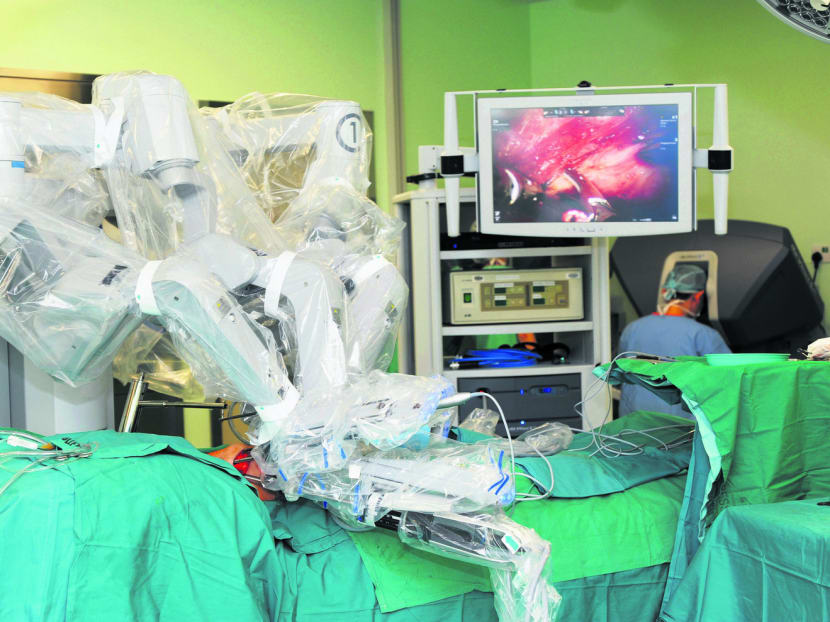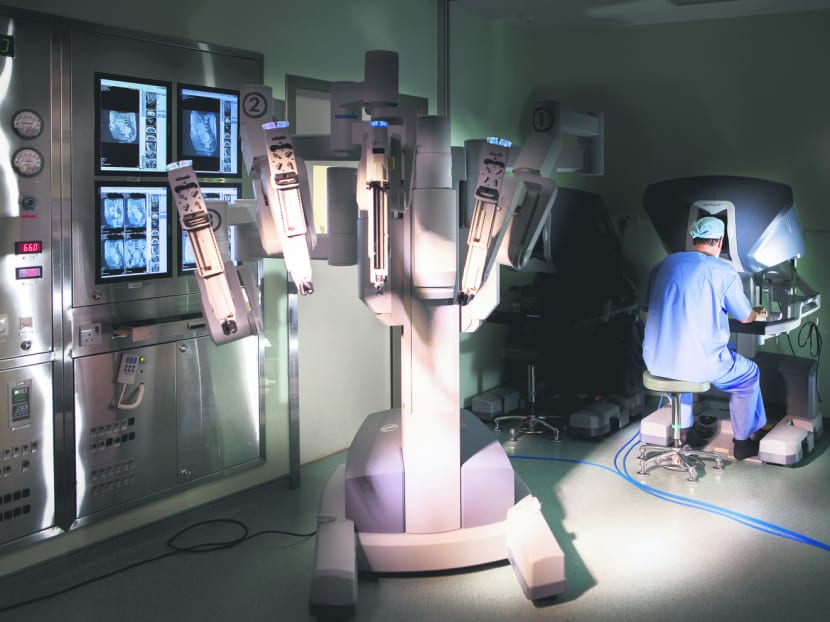You’re in good hands when surgery calls for robo ops
SINGAPORE — When Madam Jasmine Zhang was offered robot-assisted surgery as a treatment option to remove a rare pre-cancerous tumour in the pancreas, her first thought was to turn it down.


SINGAPORE — When Madam Jasmine Zhang was offered robot-assisted surgery as a treatment option to remove a rare pre-cancerous tumour in the pancreas, her first thought was to turn it down.
“My surgery would be a major one, and I did not think a robot would perform as well as human hands,” said the 38-year-old homemaker.
Mdm Zhang eventually opted for robotic surgery when she learnt about its advantages, such as faster post-op recovery and less bleeding. It also gave her a better chance of preserving her spleen and its blood supply than conventional surgery. The pancreas and spleen have interlinked blood vessels, and surgeons typically remove the latter when cancerous tumours are found in the pancreas.
“However, for pre-cancerous or benign tumours, the spleen should be ideally preserved whenever possible, as it has an important immunological function. Unfortunately, due to the complexity of the procedure, it is not unusual that attempts to save the spleen are not successful,” said Associate Professor Brian Goh, senior consultant at the Singapore General Hospital’s (SGH) department of hepato-pancreato-biliary (HPB) and transplant surgery.
Using robotic surgery, he said the chance of preserving the spleen may be up to 90 per cent, compared to the 40 to 60 per cent seen for conventional minimally invasive surgery, even with the best surgeons at the helm. More patients like Mdm Zhang are undergoing complex minimally invasive (keyhole) surgeries carried out via the mechanical arms of a surgical robot.
Robot-assisted surgeries are typically performed through keyhole incisions, using a robot with three to four ultra-dexterous “arms”. They are controlled by a surgeon seated at a nearby console, which provides a magnified 3D view of the procedure.
This minimally invasive technique allows patients to get back on their feet faster, have a shorter hospital stay, as well as experience less blood loss, wound pain and infection, say experts.
According to Associate Professor Henry Ho, head and senior consultant at the Department of Urology at SGH, robotic surgery — first introduced in Singapore in 2003 by SGH for prostate cancer — is now used to aid minimally invasive surgeries in deep cavities such as the abdomen and pelvis as well as narrow regions of the body such as the neck.
An average of 250 to 300 robotic surgeries are performed annually at SGH, including major procedures involving the liver, pancreas or bile ducts, or HPB surgeries. The hospital started a robotic HPB surgery programme in 2013, and has performed more than 60 HPB robotic surgeries.
HPB surgeries count as one of the most technically challenging surgical procedures in the abdomen, as they involve numerous delicate structures such as fine blood vessels and bile ducts, said Assoc Prof Goh. Traditionally, most of them were performed via open surgery through a large 30cm incision before minimally invasive surgical techniques were available.
But the increased dexterity, stability and 3D visualisation of robotic surgery now allow a wider range of procedures to be carried out through the minimally invasive approach, said Assoc Prof Goh. “With robotic surgery, more patients requiring complex surgery are able to successfully undergo minimally invasive surgery without the need for open surgery,” he said.
Tan Tock Seng Hospital (TTSH), another public hospital, carried out 230 robotic surgeries last year, a 30 per cent increase from 2015. Over 90 per cent of the cases were for urology, thoracic (chest) and colorectal surgeries, which correlated with the top three cancers in Singapore men, namely colorectal, lung and prostate cancer, said Adjunct Assistant Professor Png Keng Siang, chairman of TTSH’s Robotic Surgery Committee.
MULTI-TEAM KEYHOLE SURGERIES NOW POSSIBLE
Surgical robots have made it possible for surgeons to carry out complex multi-team surgeries using keyhole techniques.
In May, TTSH surgeons successfully carried out a dual-team robotic surgery for a patient whose advanced rectal cancer had also invaded the prostate gland. The cancer was removed by two teams of robotic surgeons and involved a colorectal surgeon and a urologist, who reconstructed the patient’s urinary tract and colon in a single procedure.
“As cancers may invade more than one organ system, we need teams of robotic surgeons to eradicate the cancer completely. Such multi-team surgery will be very challenging using conventional keyhole techniques. It may not be even possible and patients will have to undergo open surgery,” said Adj Assistant Prof Png.
Outcomes of robotic surgery have been positive.
Last year, the first randomised controlled trial overseas comparing robot-assisted surgery with open surgery for prostate cancer patients found that the former group did as well after three months as those who went under the knife using the traditional method.
The robotic surgery group lost less blood and reported less pain, as well as better quality of life, six weeks post-op, according to the study published in the Lancet journal.
The technology is getting better. In the pipeline is a partially-autonomous robot surgeon, known as the “Smart Tissue Autonomous Robot” or STAR system, by scientists from the Children’s National Medical Centre in Washington. It has already been tested on animals and has apparently outperformed human surgeons, according to a study published in Science Translation Medicine last year.
While robot-assisted surgeries are here to stay, the experts said they are unlikely to replace conventional surgery for now. “Less complex procedures can still be performed effectively via conventional approaches without compromising patient outcomes,” said Adj Assistant Prof Png.
For example, standard laparoscopic surgical methods are still the current standard of care for removal of the gallbladder.
Robotic surgery would be “unnecessary” in this instance, said Assoc Prof Goh. Conventional surgery is typically cheaper than robotic surgery.
Discharged six days after her major surgery, Mdm Zhang considers herself “very fortunate” to have caught the tumour in time as there was a high chance of it turning cancerous down the road.
“There was minimal scarring and I am very happy that I was able to retain my spleen, which is an important organ. My advice to people is to courageously face up to their illness and actively seek treatment,” she said.






